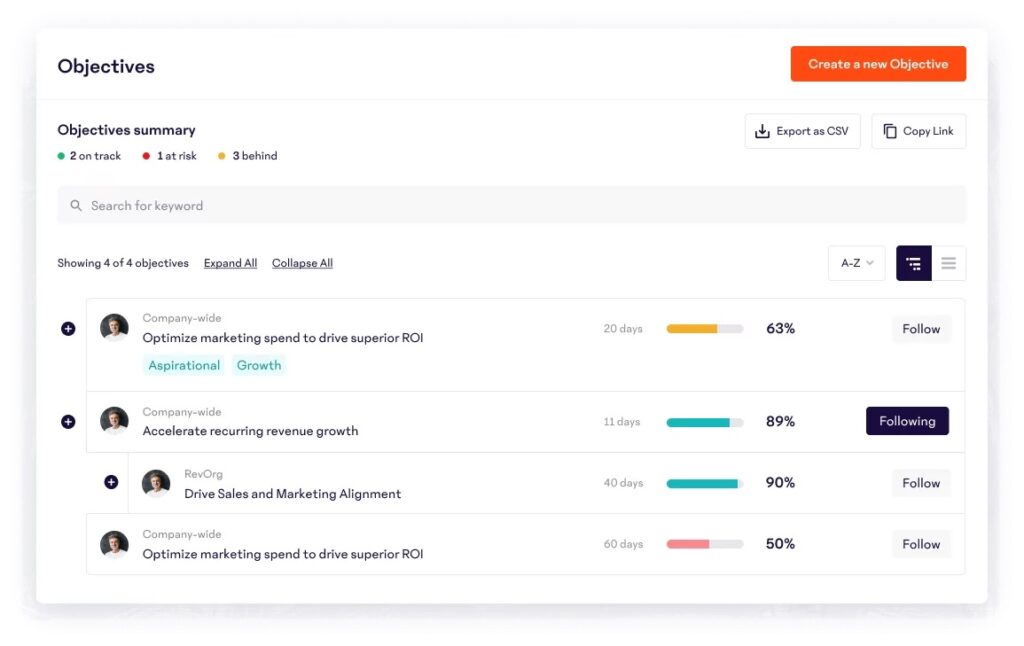The OKR System: A Proven Goal Setting Framework
As organizations focus on closing out the year strong, most leaders already have one eye on the new year and what they hope to achieve as a business. If your organization doesn’t have a formal goal-setting process in place (or you have one that needs some work) this is a great opportunity to make a big impact.
HR professionals can influence business success by championing a clear framework that aligns the organization — from the C-suite to each individual contributor — around shared goals.
Why is goal-setting so important for an organization?
Having a clear goal-setting process that is standardized across the entire org can help ensure two very important things:
- Employees clearly understand what is expected of them
- Each individual and team goal maps back to the company objectives
Having clear goals helps focus employees’ efforts. They’re like a roadmap for progress. Think of it like this: If you want to run a marathon, you probably can’t just go out and start running 26 miles every day. Most people will follow a training schedule with realistic, incremental goals. Small steps you can build on to bring you closer and closer to your ultimate goal.
By setting goals with your employees, you can ensure they’re working on the right things that will move the business forward. This also allows them to more easily gauge their progress and feel a sense of achievement in their role.

Proven goal-setting frameworks
There are a number of different frameworks your organization can leverage when rolling out a formal process around goals. At 15Five, we use the OKR process, as do many of our customers.
OKRs (Objectives & Key Results)
In the OKR system, the “Objectives” represent the goals of the organization, teams, and individuals. The “Key Results” provide the metrics to gauge performance.
Objectives should be:
- Aspirational
- Catchy
- Inspiring/Fun
Objective example: “Turn our customers into our best brand ambassadors.”
Key Results should be:
- Measurable
- Actionable
- Challenging
Key Results example: “Improve our net promoter score from +20 to +45.”
Company OKRs should be developed at the highest level of the organization and aligned to the ultimate mission and business goals. Then teams and individual employees can develop their own OKRs (which again, should map back to those at the company level).
For example, if one company objective is to double the customer base, each team in the company should have a goal that rolls up to that objective. The sales team’s goal may be to break into a new geographic region, with each salesperson having a personal goal to sign 2 new customers in that region each quarter.

When developing OKRs, here’s a handy checklist of things to consider:
Objective:
- Is it powerful/inspiring?
- Are you clear on the “why” behind it?
- What trade-offs must we make to really achieve these objectives?
KRs:
- Choose the right type of KR: baseline KR, metric KR (from X to Y, or % change), milestone/date based KR
- Are there both quantity & quality metrics?
- Are there lead & lag metrics?
- Is there appropriate stretch and ambition in these metrics? (i.e., a stretch goal may have only a 50-70% chance of success)
- Have we addressed all the potential unintended consequences?
CFRs (Conversations, Feedback, and Recognition)
CFRs can be used as an additional component of your OKR process. In his book Measure What Matters, John Doerr calls CFRs a “sibling” of OKRs and says they give the sometimes black and white grading of OKRs the color that is necessary to paint the whole picture.
CFR stands for:
- Conversations (or check-ins)
- Feedback
- Recognition
CFRs should take place during employee-manager 1:1s and at the end of each OKR cycle. Conversations should include goal-setting, reflection, and ongoing progress updates.
Feedback should be specific, constructive, and go both ways — managers giving feedback to employees and employees letting their manager know what they need to be successful.
Dive Deeper into Goal Setting
No matter what goal setting framework you decide to use, the end goal is to create organizational alignment, maximize clarity around organizational and individual goals, and foster a team that is engaged and inspired to achieve those goals together.
To learn more about the OKR process, you can check out OKRs 101: Everything You Need to Know to Get Started.
We also recently gathered a panel of experts to share their best practices and insights into the process and psychology behind goal-setting, along with actionable tips for rolling out your own goal-setting process. You can watch Preparing for 2022: HR Goal Setting Strategies on demand now.




